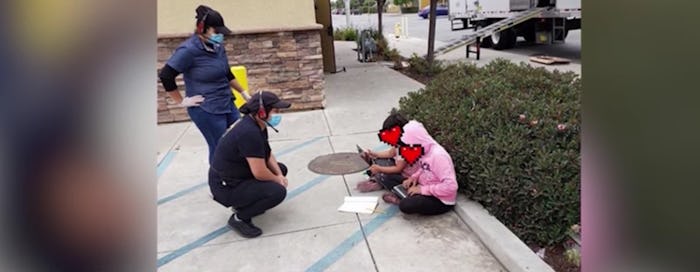News
Viral Photo Of Kids Using Taco Bell's WiFi Highlights How Stark The Digital Divide Is
Across the country, the ongoing coronavirus pandemic has forced millions of students into remote learning. But while many are settling in to the new school year from dedicated and well-equipped learning spaces in their own homes, others have struggled to find the necessary laptops, tablets, or reliable internet needed to attend school virtually. Now, a viral photo of two girls using Taco Bell's free Wi-Fi to complete their remote school work is shedding light on just how stark the digital divide can be.
"These [two] young girls were looking for a place with Wi-Fi to do their schoolwork so they sat near Taco Bell to connect to the free Wi-Fi," an Instagram user named Ms_Mamie89 posted last week. "A lot of us don't have to worry about having a proper Wi-Fi connection or a quiet place to work from home. Every student from preschool through college should have free access to reliable Wi-Fi especially now."
In the shared photo, two young girls can be seen sitting outside of a Taco Bell in Salinas, California, with laptops and a workbook as two employees of the fast-food restaurant chain crouch down to talk with them. A Taco Bell Corp spokesperson told CNN the photo "is a tough reminder of basic inequalities facing our communities" and that the individual owner of the Salinas franchise was looking into ways to support the two students.
"We and our franchisees have always been passionate about supporting youth education, and the owner of this restaurant is looking into additional ways to support these students and the broader community," a Taco Bell Corp spokesperson told CNN.
A spokesperson for the Salinas City Elementary School District (SCESD) told both CNN and USA Today the district had immediately identified the two girls as students after seeing the photo circulating online. According to the spokesperson, the district has since given the family a Wi-Fi hotspot to enable the students to connect to their virtual classrooms from home. To protect the students' privacy, the district has refrained from identifying the girls.
The district has, however, sought to distance itself from a GoFundMe campaign launched on behalf of the girls' family. "SCESD has no involvement with these GoFundMe campaigns and has no knowledge of how, and for whom, the funds will be distributed," the district said in a statement distributed over Facebook. "Please observe caution when thinking about donating to these campaigns."
A GoFundMe campaign started by Jackie Lopez has since raised more than $141,000 for the family and vowed to set the girls' mother up with a licensed accountant to help her manage the funds, 100% of which Lopez has said will go to the family.
The Salinas Police Department has also refuted allegations that officers searched the family's home or carried out a child endangerment or child welfare check. "The social media post below which asserts that Salinas police officers took action in this matter is completely false," the department said in a statement. "The Salinas Police Department has never responded to the residence where the two girls live, and the Salinas Police Department had no contact with the mother regarding child endangerment, welfare check, or any other type of call for service."
Still, the photograph is an important reminder of the digital divide hindering many families' success in remote learning. A joint report from Common Sense and Boston Consulting Group found that 15 to 16 million public school students in the United States did not have adequate internet access or computing devices to participate in remote learning.
"This new data and analysis further highlights the urgency for policymakers, educators, and private companies to address this basic educational equity issue that affects kids in every state," Common Sense founder and CEO James P. Steyer said in a statement. "Our report makes clear that during this age of distance learning, we have to act right now to close the digital divide that is leaving millions of kids behind."
If you think you’re showing symptoms of coronavirus, which include fever, shortness of breath, and cough, call your doctor before going to get tested. If you’re anxious about the virus’s spread in your community, visit the CDC for up-to-date information and resources, or seek out mental health support. You can find all of Romper’s parents + coronavirus coverage here.
